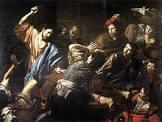
Today’s reading from John differs from the synoptic gospels, which all record this event but place it at the end of Jesus’ life. John, however, puts it at the beginning. He also uses the story to convey a much deeper meaning. There is a sense that Jesus is revealed in his dual nature as both God and man. As a devout Jew he was appalled at the trading that was being done in the court of the gentiles. The temple was meant to be a house of prayer for all nations (Isaiah 56:7) but the gentiles could only worship where the traders were. Imagine trying to pray in the Cathedral if there were stalls all around selling things and people talking at the tops of their voices! This was the place he had come as a child and recognised it as his Father’s house.
As the Son of God made man, however, he himself would replace the temple, which soon would be destroyed. The Jewish leaders demanded a miracle to prove his authority. Jesus had been tempted by Satan in the wilderness to perform spectacles which would dazzle his audience, so that they would believe in him. Jesus was not interested in attracting such a shallow following. His prediction that he would raise the temple in three days was the sign that would enhance the faith of true believers. Those who demanded wonders would reject the Resurrection, the raising of the temple of his body and indeed would try to obliterate any mention of it.
“I saw no temple in the city, for its temple is the Lord God the Almighty and the Lamb.” (Apocalypse 21:22)